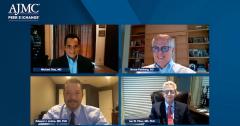
Overview of CAR T-cell Therapy in R/R NHL
Episodes in this series

An overview of the use of CAR T-cell therapy including risk stratification and standard of care for the treatment of relapsed/refractory non-Hodgkin lymphoma (NHL).
Transcript
Bruce Feinberg, DO: Hello and welcome to this AJMC® program titled, “Implications of Expanding Use of CAR T-Cell Therapy in Relapsed/Refractory Non-Hodgkin’s Lymphoma.” I am Dr. Bruce Feinberg, Vice President of Clinical Affairs and Chief Medical Officer from Cardinal Health Specialty Solutions. Joining me in this virtual discussion today are: Dr Ian Flinn, Director Blood Cancer Research Program, Tennessee Oncology, Dr Ed Licitra, Medical Oncologist, CEO Titan Health Partners, Board Member Community Oncology Alliance, and Dr Michael Diaz, Board Member and Director of Patient Advocacy, Florida Cancer Specialists, President, Community Oncology Alliance.
Today, our panel of experts will discuss the clinical impact of the use of CAR T-cell therapy in relapsed/refractory non-Hodgkin’s lymphoma and important considerations and implications for expanding use of CAR T into the community practice setting. There will be three segments in today’s program. The first will be an overview of evolving landscapes of treatment in relapsed/relapsed lymphoma. In segment II, we review approved and emerging CAR T-cell therapies in this space. And, in segment III, we will discuss what will be needed in order to be able to adequately expand CAR T therapy in the community setting in order to maintain its quality, and its safety, and its efficacy.
Thank you to our panelists in advance and for listening and watching. Let’s begin with the evolving landscape of relapsed/refractory non-Hodgkin’s treatment. Although we’re thinking big picture non-Hodgkin’s, the story begins with diffuse large B-cell lymphoma, sometimes referred to as large cell lymphoma. Ian, we’ve seen a lot of change recently in a matter of a year, two CAR T-cell therapies were approved in the relapsed/refractory setting, selinexor and Monjuvi [tafasitamab-cxix].
A disease area that didn’t have a standard care, a subspecialty of those who were transplant-ineligible upon primary CHOP/rituxan [rituximab, cyclophosphamide, hydroxydaunorubicin, oncovin, prednisone] failure suddenly has this explosion of options. If you could, take us through a brief review of the disease state and the approaches that are being taken in this relapsed/refractory setting.
Ian W. Flinn, MD, Ph: The first thing to note is, prior to the introduction of CAR T-cells, if someone failed a transplant or are ineligible for a transplant then we are talking a very short period of survival, usually six months or less. The introduction of CAR T-cells that’s radically changed the outcome for this patient population. We’re now talking about a cure rate, long-term survival of greater than two years, cure rate in many people’s minds of probably 40% in those patient population. Where it was so bleak before we now have optimism. The operate word here is cure for those patients. There are a variety of other therapies that have been developed, as you just brought up all the recent approvals, selinexor and a variety of other therapies that are approved. But goals for palliation in the relapsed setting in which they’re being used. That’s the difference there. We’re thankful that we have many different treatment options now in the relapsed setting, but, the first decision is whether you’re trying to cure somebody or not. And, if you are, then you’re moving to CAR T-cells. Not everyone is fit for CAR T-cells, and sometimes that’s not a realistic option for these patients.
Bruce Feinberg, DO: Ed, let’s talk about that patient who presents with a large cell lymphoma, large B-cell lymphoma. Standard of care for initial therapy is uniform at this point that it’s R-CHOP [rituximab, cyclophosphamide, hydroxydaunorubicin, oncovin, prednisone] for all comers? Tell me about the stratification steps in that patient, when do you determine them to be relapsed/refractory? And then in your practicing community, what would be the determining points for them to be stem cell eligible or stem cell ineligible?
Edward J. Licitra, MD, PhD: Rituxan and CHOP are still used as first-line therapy, although rituxan and EPOCH [etoposide,prednisone, vincristineis] commonly used in our practice here in New Jersey. Most patients are risk stratified based upon standard criteria. They’re treated up front with either R-CHOP [rituximab, cyclophosphamide, hydroxydaunorubicin, oncovin, prednisone] or R-EPOCH [rituxan, etoposide, prednisone, vincristineis] and then based upon their recurrence we would look toward other options. Ideally, they would be cured, a number of those patients are. However, a number are not cured. At that point, we would look at standard criteria, age, performance status and determine whether they were in fact transplant eligible. Those patients would then go on to receive some other chemotherapy to make sure that they had chemotherapy responsive disease and if so, they go on to a stem cell transplant. Ideally at that point, people would have a durable response. If not and if they relapsed, then we’re looking at CAR T-cell options for those patients that would be fit or clinical trial options.
Newsletter
Stay ahead of policy, cost, and value—subscribe to AJMC for expert insights at the intersection of clinical care and health economics.


























































